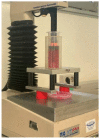Viability Study on the Use of Three Different Gels for 3D Food Printing
- PMID: 37754417
- PMCID: PMC10530510
- DOI: 10.3390/gels9090736
Viability Study on the Use of Three Different Gels for 3D Food Printing
Abstract
Three-dimensional food printing is one of the modern techniques for food customization. The difficulty of this technique lies in the formulation of new matrices. These new formulations must have good extrusion characteristics and, at the same time, maintain the structure once printed. These qualities are related to textural and rheological properties. Printability studies are those whose objective is to know the above properties. Some authors have correlated printability with rheological and physicochemical parameters. The aim of this study was to characterize three gels to test prediction models and to determine the most important rheological and textural parameters (G', G″, Tanδ, maxF, average) in printability. The formulations studied were bovine gelatin (4%) with kappa-carrageenan (0.5%) (Gb + K), porcine gelatin (5%) plus iota-carrageenan (2%) (Gp + I), and methylcellulose (4%) (MC). The samples were characterized by an oscillatory test for the rheological properties and an extrusion test for the textural properties. In addition, the density was obtained to apply the predictive models and correlate the rheological and textural parameters to determine their influence. Gp + I and Gb + K showed higher values of maximum force in the extrusion test than MC, but MC had less deviation in the mean force during the test. All the samples showed a predominantly elastic behavior and damping factor (Tanδ) between 0.14 (Gb + K) and 0.37 (MC). It was observed that the tangent of the phase angle (Tanδ) had a large positive influence on the maximum and average force studied in the extrusion tests. The sample results did not match 100% with the predictions made from the models. It was possible to print samples that were higher in height without obtaining deformations over time of more than 5%. Further work is needed to optimize models and parameters for more accurate prediction.
Keywords: 3D food printing (3DFP); extrusion analysis; gels; image essay; rheological properties.
Conflict of interest statement
The authors declare no conflict of interest.
Figures







References
-
- Caporizzi R., Derossi A., Severini C. Cereal-Based and Insect-Enriched Printable Food. Elsevier Inc.; Amsterdam, The Netherlands: 2019.
-
- Jagadiswaran B., Alagarasan V., Palanivelu P., Theagarajan R., Moses J.A., Anandharamakrishnan C. Valorization of food industry waste and by-products using 3D printing: A study on the development of value-added functional cookies. Future Foods. 2021;4:100036. doi: 10.1016/j.fufo.2021.100036. - DOI
-
- Uribe-Wandurraga Z.N., Igual M., Reino-Moyón J., García-Segovia P., Martínez-Monzó J. Effect of Microalgae (Arthrospira platensis and Chlorella vulgaris) Addition on 3D Printed Cookies. Food Biophys. 2020;16:27–39. doi: 10.1007/s11483-020-09642-y. - DOI
-
- Martínez-Monzó J., Cárdenas J., García-Segovia P. Effect of Temperature on 3D Printing of Commercial Potato Puree. Food Biophys. 2019;14:225–234. doi: 10.1007/s11483-019-09576-0. - DOI
Grants and funding
LinkOut - more resources
Full Text Sources

